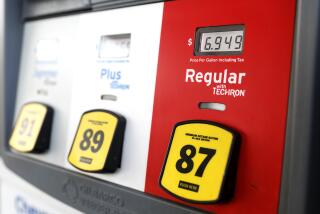How to beat the gas-price woes
President’s Day weekend seemed to be a turning point for gasoline prices, which look to be increasing faster than a speeding bullet. If the trend continues, analysts say, we may see $5 a gallon and beyond. That will put into play some of the measures that made the gas price run-up of 2008 (in June, gas reached $4.62 a gallon) so painful: taxi cab and shuttle service fuel surcharges, hotel energy surcharges and ever higher air fares. Ouch.
It may even cross your mind to scuttle your driving vacation. But think about some things you can do to cope with this latest blow to your wallet:
Do the math to put the price in perspective. Let’s say you’re driving from Los Angeles to San Francisco, which is about 385 miles. If your vehicle gets 27 mpg and you’re paying $4.32 a gallon for regular gas (that was the price early last week in Los Angeles, according to AAA), your one-way trip will cost you just more than $61. A year ago, it would have cost you a little more than $52. You’ll pay about 6 cents a gallon more in San Francisco for the fuel home, but your out-of-pocket increase is still only about $20 more than it would have been a year ago.
Focus on finding savings in the bigger expenses. It’s generally not the cost of a gallon of gas. If you’re on a weeklong vacation and you’re not staying with Aunt Hilda and Uncle Fudd, you’ll be shelling out some money for a place to stay. In 2010, the most recent data available from the American Hotel & Lodging Assn., the average room rate was $98.07. For a six-night stay, that’s going to be more than $600 by the time you add taxes. Look for ways to reduce your per-night lodging cost. Although Priceline’s bidding for rooms has its drawbacks (it’s generally nonrefundable), I’ve scored major deals using it with help from BiddingForTravel.com, the “here’s-how-to-do-even-better” site.
Find compensations for the increased expense. Anne Banas, executive editor of SmarterTravel.com, thinks hotels may bring back the gas-card incentive. When fuel went up four years ago, many hotels offered customers a gas card or some compensation to help ease the pain. But, Banas said, make sure you do the math to ensure you’re really getting a deal. Look, too, for extras that hotels will include that save you money. On a recent Arizona trip, I stayed at places that included breakfast — and it was more than a stale Danish. These hot-cooked breakfasts easily saved hubby and me about $20 by the time tax was added, never mind the convenience (and gas savings) of having to walk only a few yards to the lobby.
Consider buying gas with a cash-back card. The Discover card, which usually offers 1% back, is offering 5% back through the end of March. (This also applies to movies and museums.) If you’re paying $4.32 a gallon for gas, using the cash-back feature brings that down to about $4.11. The card is expected to run the offer again from July through September at the height of the summer vacation driving season, said Dana Traci, vice president of rewards at Discover. Info: https://www.discover.com
Don’t drive. As you consider a vacation, think about cities or places that are public transportation friendly. For that matter, take the train. Amtrak is offering a deal for college-bound students who want to check out campuses (https://www.lat.ms/yPLrDj. Such cities as Santa Barbara (https://www.santabarbaraca.com and San Luis Obispo (www.slocarfree.org) also tout their car-free friendliness.
Take a day off from your days off. In the gas-price run-up of 2008 “there was more of a cutting back on days and distance,” said Jeffrey Spring, a Southern California Auto Club spokesman. “We didn’t see the wholesale abandonment of vacations.” Coming home a day earlier? Not a bad way to start your re-entry program.
Get the best mileage you can. After the L.A. Times Travel Show, I was given about six dozen mini-shopping bags that feature the Travel section. A month later, most of them are still in the car’s trunk. Meanwhile, my mileage has decreased about 3 mpg (my hybrid makes it easy — some would say almost mandatory — to watch). Along with making sure our cars are in good working order, the standard advice includes working to dejunk the trunk, and that’s what I’m going to do, with your help. I’ll send one of the bags to the first 50 or so people who email travel@latimes.com with the words GAS BAG in the subject line and a complete name and address in the body. My mileage goes up, and you get a small reward for making it to the end of this column.
More to Read
Sign up for The Wild
We’ll help you find the best places to hike, bike and run, as well as the perfect silent spots for meditation and yoga.
You may occasionally receive promotional content from the Los Angeles Times.







